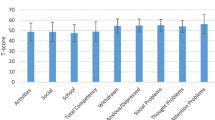Abstract
This paper reports the results of a small follow-up study on 17 autistic adolescents and young adults who are also intellectually retarded. The aim is to examine how far scores on the Psychoeducational Profile (PEP) predicts scores on the Adolescent and Adult Psychoeducational Profile (AAPEP) 5 years later. One subscale eye-hand coordination significantly predicts the scores on three subscales of the AAPEP: Vocational Skills, Independent Functioning, and Vocational Behavior. Imitation predicts Interpersonal Behavior. Fine Motor predicts Leisure Skills and Cognitive Performance predicts Functional Communication. Results are interpreted in terms of the implications for educational intervention programs with autistic adolescents and adults.
Similar content being viewed by others
References
Bartak, L., & Rutter, M. (1971). Educational treatment of autistic children. In M. Rutter (Ed.),Infantile autism: Concepts, characteristics and treatment. London: Churchill.
Creak, E. M. (1963). Childhood Psychosis. A review of 100 cases.British Journal of Psychiatry, 109, 84–89.
DeMyer, M. K., Alpern, G. D., Barton, S., DeMyer, W. E., Churchill, D. W., Hingtgen, J. N., Bryson, C. Q., Pontius, W., & Kimberlin, C. (1972). Imitation in autistic, early schizophrenic and non-psychotic subnormal children.Journal of Autism and Childhood Schizophrenia, 2, 264–287.
DeMyer, M. K., Barton, S., DeMyer, W. E., Norton, J. A., Allen, J., & Steele, R. (1973). Prognosis in autism: A follow-up study.Journal of Autism and Childhood Schizophrenia, 3, 199–245.
DSM-III. (1985).Manual diagnóstico y estadístico de los trastorno mentales. Barcelona, Spain: Masson.
Eisenberg, L. (1957). The autistic child in adolescence.American Journal of Psychiatry, 112, 607–612.
Eisenberg, L. (1957). The course of childhood schizophrenia.Archives of Neurology and Psychiatry, 78, 69–83.
Gittelman, M., & Birch, H. G. (1967). Childhood schizophrenia: intellectual, neurologic, status, perinatal risk, prognosis and family pathology.Archives of General Psychiatry, 17, 16–25.
Ihrig, K., & Wolchik, S. A. (1988). Peer versus adult models and autistic children's learning: Acquisition, generalization and maintenance.Journal of Autism and Developmental Disorders, 18, 67–79.
Kanner, L. (1971). Follow-up study of 11 autistic children originally reported in 1943.Journal of Autism and Childhood Schizophrenio, 1, 119–145.
Kanner, L. (1973).Childhood psychosis: Initial studies and new insights. Washington, DC: Winston.
Kanner, L., & Eisenberg, L. (1955). Notes on the follow-up studies of autistic children. In P. H. Hoch & J. Zubin (Eds.),Psychopathology of childhood. New York: Grune and Stratton.
Kanner, L., & Eisenberg, L., (1956). Early infantile autism 1943–55.American Journal of Orthopsychiatry, 26, 55–65.
Kanner, L., & Lesser, L. I. (1956). Early infantile autism.Pediatric Clinics of North America, 5, 711–730.
Lockyer, L., & Rutter, M. (1969). A five to fifteen year follow-up study of infantile psychosis: III Psychological aspects.British Journal of Psychiatry, 115, 865–882.
Lotter, V. (1966), Epidemiology of autistic conditions in young children: I. Prevalence.Social Psychiatry, 1, 124–137.
Lotter, V. (1984). Estudios de seguimiento. In M. Rutter & E. Schopler (Eds.),Autismo. Madrid, Spain: Alhambra.
McGee, G. G., Krantz, P. J., & McClannahan, L. E. (1984). Conversational skills for autistic adolescents: teaching assertiveness in naturalistic game settings.Journal of Autism and Developmental Disorders, 14, 319–330.
Mesibov, G. B. (1984). Social skills training with verbal autistic adolescents and adults: A program model.Journal of Autism and Developmental Disorders, 14, 395–404.
Mesibov, G., Schopler, E., Schaffer, B., & Landrus, R. (1988).Individualized assessment a treatment for autistic and developmentally disabled children. Vol. IV. Adolescent and adult psychoeducational profile (AAPEP). Austin, TX: Pro-Ed.
Norusis, M. J. (1985).Advanced statistics SPSS/PC + tm. Chicago, IL: SPSS.
Rumsey, J. M., Rapoport, J. L., & Sceery, W. R. (1985). Autistic children as adults: psychiatric, social and behavioral outcomes.Journal of American Academy of Child Psychiatry, 24, 465–473.
Rutter, M. (1970). Autistic children: Infancy to adulthood.Seminars in Psychiatry, 2, 435–450.
Rutter, M., Greenfield, D., & Lockyer, L. (1967). A five to fifteen year follow-up of infantile psychosis: II. Social and behavioral outcome.British Journal of Psychiatry, 113, 1183–1199.
Rutter, M., & Lockyer, L. (1967). A five to fifteen year follow-up of infantile psychosis: I. Description of the sample.British Journal of Psychiatry, 113, 1169–1182.
Schopler, E., & Reichler, R. (1979).Individualized assessment and treatment of autistic and developmentally disabled children: Vol. 1. Psychoeducational profile (PEP). Austin, TX: Pro-Ed.
Szatmari, P., Bartolucci, G., Bremner, R., Bond, F., & Rich, S. (1989). A follow-up study of high-functioning autistic children.Journal of Autism and Developmental Disorders, 19, 213–225.
Wing, L. (1969). The handicaps of autistic children—a comparative study.Journal of Child Psychology and Psychiatry, 10, 1–40.
Wing, L., & Everard, P. (1982).Autismo infantil. Aspectos médicos y educativos. Madrid, Spain: Santillana.
Author information
Authors and Affiliations
Rights and permissions
About this article
Cite this article
Perez, J.M., del Sol Fortea Sevilla, M. Psychological assessment of adolescents and adults with autism. J Autism Dev Disord 23, 653–664 (1993). https://doi.org/10.1007/BF01046107
Issue Date:
DOI: https://doi.org/10.1007/BF01046107




